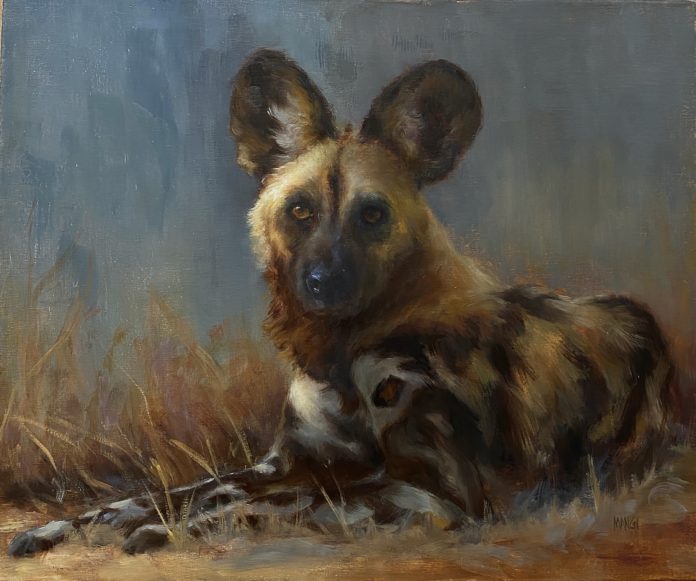Johanne Mangi explains how to use intuition when painting, and what a difference it can make when you “let go” during the creative process.
Intuition and Letting Go
by JOHANNE MANGI
What exactly is intuition and how does one access it? Since it’s much easier to describe an object rather than a concept we probably don’t think too much beyond the word. It’s an ingredient that is worth understanding better as it will boost your artistic efforts. It costs nothing and won’t make you fat!
To tap into intuition takes a bit of “letting go.” (Kind of like how we’ve been dressing these last several months.) It’s letting your subconscious be conscious. That’s about as academic as I’m going to get. We’ve got a lot going on underneath our layers but we don’t always acknowledge it. As artists we tend to be more sensitive to our surroundings and we drink it all in. We see things around us that the average person is not aware of. But we still fall into the trap of using a minuscule amount of our brain power.
On Imagination
Albert Einstein said “Imagination is more important than knowledge.” That’s a great quote. I daydreamed A LOT when I was young putting myself in different scenarios creating a different world. I never thought of myself as having much of an imagination though (a ridiculous notion, but one I believed). It was probably a result of many hours sitting with paper and pencil and not being able to think of a single thing to draw. More like I couldn’t make up my mind WHAT to draw. Now that I think of it I probably had ADD! Anyway, I started copying greeting cards out of desperation. I just had to draw something and it had to be NOW! Those efforts many years ago were stored in the deep recesses of my brain.
Think: Imagination – Knowledge – Experience – Intuition. To unleash intuition you need to let what’s in your subconscious float to the surface. That’s where letting go comes in. Deep breaths. “I can do this” mentality. Believe that you can. Desire.
One thing I always recognized from an early age was my ability to utilize intuition, although I never called it that. I relied on my gut many times because it rarely failed me. We say the term but never think about the particulars of it. I often wondered how I developed this. I do know that the more my gut proved right the more I was willing to trust it. The more I trusted it the better it got. It certainly helped me through my early years while I was carving a career out for myself. I pretty much survived on intuition until knowledge caught up. Knowledge boosted its value. Back in my school days I double majored in Psychology and Business Management. I was fascinated by what made people tick. More importantly, I wanted to learn what made ME tick. Isn’t that a scary thought!
That gut feeling comes from deep within. Our brain links current experience with past experience and knowledge then throws in a substantial amount of emotional certainty. This must be the part where my husband tells people, “She’s not always right, but always certain!” However, don’t be mistaken. I’m not talking about strictly emotional decisions here. Feelings are important but it’s the combination of that and all that you’ve learned that are the foundation for opening you up to new possibilities in decision making.
On Painting Intuitively
Sometimes when I’m painting I think too much. I can get frustrated and feel like I’m at a dead end. Out comes the bigger brush. I turn my brain off and let my brush do the talking. Whatever it needs to do I let it do. I might grab some color (always in harmony) and off we go. It’s oil so I’m never worried that I can’t alter what happens. I release the brush to do whatever it needs to do. I’m pulling out from within knowledge that has been waiting for this moment. None of “don’t do this, do that.” I want to see where it leads me, which means there are no boundaries. These aren’t slow strokes. They’re lively and they jump. It puts me in another zone, which is what I needed. This to me is painting intuitively. It’s like going to bed with a problem unsolved and waking up the next day with the solution.
The moral of the story? Be brave! Trust in yourself. It might surprise you.
~Johanne
Learn more from Johanne Mangi, including how to paint horses and dog portraits, in her art video workshops. “The Fine Art of Painting Dog Portraits” and “The Fine Art of Painting Horse Portraits” include over 11 hours of in-depth instruction! (Preview them below)
.
.
There are plenty of painting tips, techniques, and strategies to be uncovered in this training, which will help you create beautiful, emotionally impactful portraits of dogs and horses. Click here to learn more about the Johanne Mangi Combo Set.




